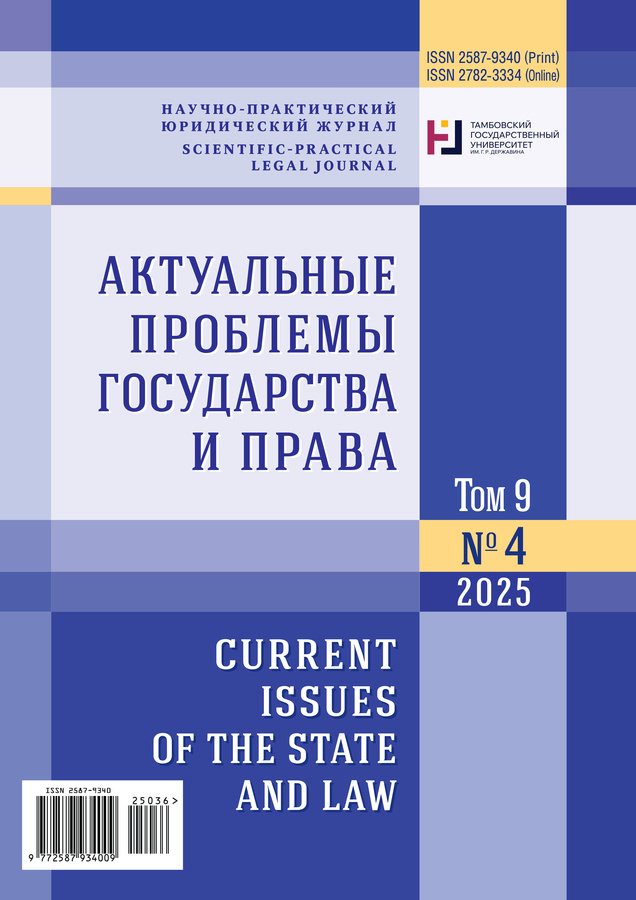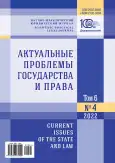Защита половой неприкосновенности несовершеннолетних в сети Интернет
- Авторы: ШУНЯЕВА В.А.1
-
Учреждения:
- ФГБОУ ВО «Тамбовский государственный университет им. Г.Р. Державина»
- Выпуск: Том 6, № 4 (2022)
- Страницы: 611-618
- Раздел: Материальное право
- URL: https://journal-vniispk.ru/2587-9340/article/view/303904
- ID: 303904
Цитировать
Полный текст
Аннотация
Защита половой неприкосновенности несовершеннолетних является одной из ключевых задач уголовно-правовой охраны. Защита детей от сексуального насилия закреплена как в отечественном законодательстве, так и на уровне международных актов. При этом данные преступления всегда считались одними из самых опасных преступных деяний, так как они приводят к потере здоровья и жизни этих детей, а также к разрушенной психике. Не последнее место в совершении насильственных преступлений против половой неприкосновенности детей играет сеть Интернет. Целью исследования стала гипотеза о необходимости повышения эффективности противодействия преступлениям, посягающим на половую неприкосновенность несовершеннолетних посредством сети Интернет. Методологическую основу исследования составили методы анализа и синтеза, которые позволяют выявить причинно-следственную связь сети Интернет и роста преступлений против половой неприкосновенности. Статистический метод дал возможность проследить динамику роста рассматриваемых преступлений, были также использованы логический метод изложения материала исследования, а также метод моделирования и абстрагирования. Проанализированы возможности сети Интернет для совершения обозначенных преступлений. К таким возможностям было отнесено: разнообразие специальных цифровых программ, позволяющих установить контакт с большим количеством детей, помогающих также собирать данные о детях и использовать их для вовлечения несовершеннолетних в совершении в отношении них преступлений, посягающих на их половую неприкосновенность; широкое распространение мобильных устройств с выходом во Всемирную сеть позволяет и самим несовершеннолетним распространять свои изображения сексуального характера, которые становятся достоянием взрослых лиц, заинтересованных в их получении. Акцентировано внимание на средствах совершения обозначенных преступлений: массовом распространении, размещении и продвижении в сети Интернет материалов, содержащих изображения сексуального насилия над детьми; непосредственной реализации и получении финансового вознаграждения за такие материалы; создании веб-студий для просмотра порнографических материалов; организации детского секс-туризма. Выделены следующие формы сексуальной эксплуатации и насилия над детьми: интернет-приставания, втягивание детей в просмотр материалов пагубного для его развития характера, где демонстрируется и культивируется алкоголизм, наркотизм, проституция; вовлечение несовершеннолетних в сексуальный контакт; кибербуллинг на основе реальных и фейковых изображений сексуального характера несовершеннолетних; торговля несовершеннолетними в сексуальное рабство и т. д.Результаты проведенного исследования направлены на совершенствование механизма противодействия преступлениям, посягающим на половую неприкосновенность несовершеннолетних посредством сети Интернет.
Об авторах
Вера Анатольевна ШУНЯЕВА
ФГБОУ ВО «Тамбовский государственный университет им. Г.Р. Державина»
Автор, ответственный за переписку.
Email: vera1705@mail.ru
ORCID iD: 0000-0003-0035-8013
SPIN-код: 9161-1221
кандидат юридических наук, доцент, доцент кафедры уголовного права и процесса Института права и национальной безопасности, директор Института права и национальной безопасности
Россия, Российская Федерация, 392000 г. Тамбов, ул. Интернациональная, 33Список литературы
- Оганов А.А. Принципы, оказывающие влияние на противодействие преступлениям в отношении несовершеннолетних в глобальном пространстве // Вестник экономической безопасности. 2019. № 2. С. 139-144. doi: 10.24411/2414-3995-2019-10076
- Рыжков В.Б. Взаимодействие государств-участников Европейского Союза в борьбе с сексуальной эксплуатацией детей и детской порнографией // International Law and International Organizations. 2021. № 2. С. 77-91. doi: 10.7256/2454-0633.2021.2.35484
- Голованова Н.Е. Новые формы онлайн-преступности за рубежом // Журнал зарубежного законодательства и сравнительного правоведения. 2019. № 3. С. 42-57. doi: 10.12737/jflcl.2019.3.4
- Ильяшенко А.Н., Самойленко К.В., Сапрунов А.Г., Палазян А.С. Противодействие сексуальной насильственной преступности в семье. Краснодар, 2015. 170 с. https://elibrary.ru/tunypx
- Клочкова А.В., Пристанская О.В.Виктимологические и уголовно-правовые проблемы информационной безопасности и их защиты от сексуальной эксплуатации // Вестник Московского университета. Серия 11. Право. 2017. № 6. С. 86-105. https://elibrary.ru/yrresk
- Оганов А.А. Признаки, воздействующие на борьбу с киберпреступностью в отношении несовершеннолетних в интернет-пространстве // Вестник Московского университета МВД России. 2019. № 3. С. 137-140. doi: 10.24411/2073-0454-2019-10152
Дополнительные файлы










